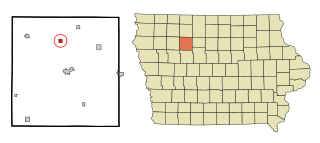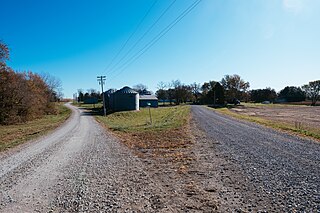
Osceola County is a county located in the U.S. state of Iowa. As of the 2020 census the population was 6,192, making it the state's fifth-least populous county. It is named for Seminole war chief Osceola. The county seat is Sibley, named for H. H. Sibley of Minnesota.

Clarke County is a county located in the U.S. state of Iowa. As of the 2020 census, the population was 9,748. The county seat is Osceola. The county was formed in January 1846, one of twelve counties established by legislative action in a comprehensive act. It was named for James Clarke, a Governor of the Iowa Territory.

Marathon is a city in Buena Vista County, Iowa, United States. The population was 230 at the time of the 2020 census. The food writer Richard Olney grew up in Marathon.

Van Wert is a city in northern Decatur County, Iowa, United States. The population was 178 at the time of the 2020 census.

Dyersville is a city in eastern Delaware County and western Dubuque County in the U.S. state of Iowa. It is part of the Dubuque, Iowa, Metropolitan Statistical Area. The population was 4,477 at the time of the 2020 census, up from 4,035 in 2000.

Hillsboro is a city in Henry County, Iowa, United States. The population was 163 at the time of the 2020 census.

St. Paul is a city in Lee County, Iowa, United States. The population was 109 at the time of the 2020 census. It is part of the Fort Madison-Keokuk Micropolitan Statistical Area

Wapello is a city in and the county seat of Louisa County, Iowa, United States. The population was 2,084 at the time of the 2020 census.

Macksburg is a city in Madison County, Iowa, United States. The population was 97 at the time of the 2020 census. It is part of the Des Moines–West Des Moines Metropolitan Statistical Area.

St. Charles is a city in Madison County, Iowa, United States. The population was 640 at the time of the 2020 census. It is part of the Des Moines–West Des Moines Metropolitan Statistical Area.

Truro is a city in southeast Madison County, Iowa, United States. The population was 509 at the time of the 2020 census. Truro is part of the Des Moines–West Des Moines Metropolitan Statistical Area.

Gilman is a city in the southeastern corner of Marshall County, Iowa, United States. The population was 542 at the time of the 2020 census.

Paullina is a city in O'Brien County, Iowa, United States. The population was 982 at the 2020 census.

Ashton is a city in Osceola County, Iowa, United States. The population was 436 at the 2020 census.

Harris is a city in Osceola County, Iowa, United States. The population was 151 at the time of the 2020 census.

Havelock is a city in Pocahontas County, Iowa, United States. The population was 130 at the time of the 2020 census.

Maloy is a city in southwest Ringgold County, Iowa, United States, along the Little Platte River. The population was 22 at the time of the 2020 census.

Westphalia is a city in Shelby County, Iowa, United States. The population was 126 at the time of the 2020 census.

Sloan is a city in Woodbury County, Iowa, United States. It is part of the Sioux City, IA–NE–SD Metropolitan Statistical Area. The population was 1,042 at the time of the 2020 census.

Bevington is a city in Madison and Warren Counties in the U.S. state of Iowa. The population was 57 at the 2020 census. It is part of the Des Moines–West Des Moines Metropolitan Statistical Area.



























